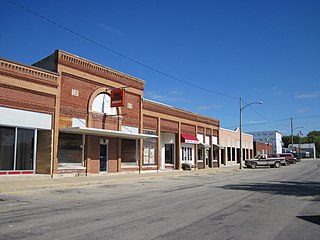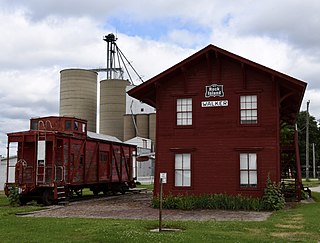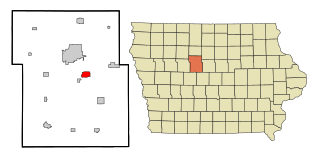
Marion County is a county in the U.S. state of Iowa. As of the 2020 census, the population was 33,414. The county seat is Knoxville. It is named for Francis Marion, a brigadier general from South Carolina in the American Revolutionary War.

Ladd is a village in Bureau County, Illinois, United States. The population was 1,236 at the 2020 census. It is part of the Ottawa Micropolitan Statistical Area. Ladd is most known for Rip's Tavern, and for a Vietnam War tank located in the center of its park.

Cincinnati is a city in Appanoose County, Iowa, United States. The population was 290 in the 2020 census, a decline from 428 in 2000.

Urbana is a city in Benton County, Iowa, United States. The population was 1,554 at the time of the 2020 census. It is part of the Cedar Rapids Metropolitan Statistical Area.

Lowden is a city in Cedar County, Iowa, United States. The population was 807 at the time of the 2020 census.

Thornburg is a village in Keokuk County, Iowa, United States. The population was 45 at the time of the 2020 census. Its sole enterprise is the Tri-County Community School, a public school serving grades K-12.

What Cheer is a city in Keokuk County, Iowa, United States. It is a former coal town, and from the 1870s to the early 1900s was one of the major coal-producing centers of Iowa. Its greatest recorded population was 3,246, in the 1890 census. The population was 607 in the 2020 census.

Marion is a city in Linn County, Iowa, United States. The population was 26,294 at the 2000 census and was 41,535 in 2020, an increase of 58%. The city is located next to Cedar Rapids and part of the Cedar Rapids Metropolitan Statistical Area.

Palo is a city in Linn County, Iowa, United States. The population was 1,407 at the time of the 2020 census. It is part of the Cedar Rapids Metropolitan Statistical Area.

Robins is a city in Linn County, Iowa, United States. The population was 3,353 at the time of the 2020 census. It is a suburb of Cedar Rapids and part of the Cedar Rapids Metropolitan Statistical Area.

Walker is a city in Linn County, Iowa. The population was 688 at the 2020 census. It is part of the Cedar Rapids, Iowa metropolitan area.

Lucas is a city in Lucas County, Iowa, United States. The population was 172 at the time of the 2020 census.

Beacon is a city in Mahaska County, Iowa, United States. The population was 445 at the 2020 census.

Bussey is a city in southeast Marion County, Iowa, United States. The population was 387 at the time of the 2020 census.

Knoxville is a city in Marion County, Iowa, United States. The population was 7,595 at the time of the 2020 census, an increase from 7,313 in the 2010 census. It is the county seat of Marion County. Knoxville is home of the National Sprint Car Hall of Fame & Museum, located next to the famous Knoxville Raceway dirt track.

Melcher-Dallas is a city in Marion County, Iowa, United States. The population was 1,195 at the time of the 2020 census.

Lovilia is a city in Monroe County, Iowa, United States. The population was 472 at the time of the 2020 census.

Coalville is a census-designated place (CDP) in Webster County, Iowa, United States. The population was 610 at the 2010 census. The community is located on U.S. Route 20 near Fort Dodge's large gypsum mines.

Lehigh is a city in Webster County, Iowa, United States. The population was 395 at the time of the 2020 census.

Grant Town is a town in Marion County, West Virginia, in the eastern United States. The population was 690 at the 2020 census.





















